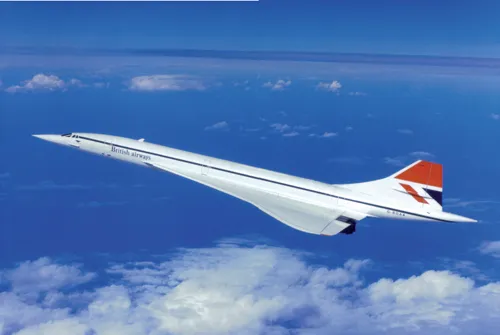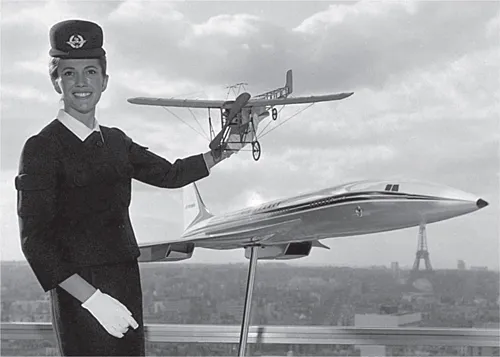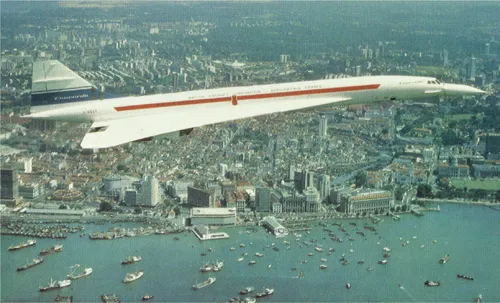
eBook - ePub
Concorde
Supersonic Icon - 50th Anniversary Edition
Ingo Bauernfeind
This is a test
Partager le livre
- 176 pages
- English
- ePUB (adapté aux mobiles)
- Disponible sur iOS et Android
eBook - ePub
Concorde
Supersonic Icon - 50th Anniversary Edition
Ingo Bauernfeind
Détails du livre
Aperçu du livre
Table des matières
Citations
À propos de ce livre
This lavishly illustrated volume tells the amazing story of Concorde, the supersonic icon that has been capturing the world's imagination since its maiden flight in 1969. With personal accounts written by former pilots and crew members, it covers Concorde's history, her technology as well as her undisputed and timeless charisma. Moreover, this volume will focus on her legacy and the ambitious undertaking of bringing one Concorde back to service as a heritage aircraft. Included is a download video about Concorde.
Foire aux questions
Comment puis-je résilier mon abonnement ?
Il vous suffit de vous rendre dans la section compte dans paramètres et de cliquer sur « Résilier l’abonnement ». C’est aussi simple que cela ! Une fois que vous aurez résilié votre abonnement, il restera actif pour le reste de la période pour laquelle vous avez payé. Découvrez-en plus ici.
Puis-je / comment puis-je télécharger des livres ?
Pour le moment, tous nos livres en format ePub adaptés aux mobiles peuvent être téléchargés via l’application. La plupart de nos PDF sont également disponibles en téléchargement et les autres seront téléchargeables très prochainement. Découvrez-en plus ici.
Quelle est la différence entre les formules tarifaires ?
Les deux abonnements vous donnent un accès complet à la bibliothèque et à toutes les fonctionnalités de Perlego. Les seules différences sont les tarifs ainsi que la période d’abonnement : avec l’abonnement annuel, vous économiserez environ 30 % par rapport à 12 mois d’abonnement mensuel.
Qu’est-ce que Perlego ?
Nous sommes un service d’abonnement à des ouvrages universitaires en ligne, où vous pouvez accéder à toute une bibliothèque pour un prix inférieur à celui d’un seul livre par mois. Avec plus d’un million de livres sur plus de 1 000 sujets, nous avons ce qu’il vous faut ! Découvrez-en plus ici.
Prenez-vous en charge la synthèse vocale ?
Recherchez le symbole Écouter sur votre prochain livre pour voir si vous pouvez l’écouter. L’outil Écouter lit le texte à haute voix pour vous, en surlignant le passage qui est en cours de lecture. Vous pouvez le mettre sur pause, l’accélérer ou le ralentir. Découvrez-en plus ici.
Est-ce que Concorde est un PDF/ePUB en ligne ?
Oui, vous pouvez accéder à Concorde par Ingo Bauernfeind en format PDF et/ou ePUB ainsi qu’à d’autres livres populaires dans Technology & Engineering et Aviation. Nous disposons de plus d’un million d’ouvrages à découvrir dans notre catalogue.
Informations
Sous-sujet
Aviation
THE AGE OF CONCORDE
“It is a magnificent achievement that today British Airways are starting their first Concorde service. It is the outcome of fourteen years’ close collaboration on design, production and testing between the British and French aircraft industries. I congratulate all those who have contributed to today’s achievement and I wish every success to this beautiful aircraft now going into service.”
– HM Queen Elizabeth II
Naming
In order to honour the Anglo-French cooperation which made a supersonic airliner possible in the first place, Timothy Clarke, the son of BAC Filton’s publicity manager, suggested naming the aircraft ‘Concorde’, based on the French word concorde which has an English equivalent, concord. The meaning of both words is agreement, union, or harmony. After the British had changed it into ‘Concord’, the French put the ‘e’ back on, which resulted in an uproar in Britain. Finally, during the rollout of the Concorde prototype 001 in Toulouse in 1969, Tony Benn, Britain’s Minister of Technology, made the announcement that the decision had been made to accept ‘Concorde’ as the official name but that the ‘e’ stood for Excellence, England, Europe and Entente, thus able to pacify the critics who did not want to see the French ‘e’ on the aircraft.
During her development Concorde’s designers and engineers overcame numerous technological challenges but costs spiralled to about five times the initial estimate. During the early 1970s, while the general public in France and Britain was still showing keen interest in the ‘airliner of the future’, the British parliament began expressing concerns over the project’s soaring expense, and even began considering a cancellation of the entire project. However, the Anglo-French agreement included a clause that if either side wanted to cancel the programme this gave the other party the right to claim damages. Therefore, it was speculated that the possible financial burden of cancelling could have been bigger than the costs of continuing. Despite the escalating costs the two nations decided to resolve their differences and carry on.

An Air France flight attendant advertises the age of supersonic air travel.
[© Air France]
Sales Tours
While still being used for test flights, both France and Britain sent their prototypes on demonstration and sales tours around the world in order to attract more potential buyers. In 1971 the French-built Concorde 001 made her first transatlantic flight via the Cape Verde islands, Cayenne and Sao Paolo, finally arriving in Rio de Janeiro where she received a warm welcome and made several demonstration flights. During the following year, Philip Cairns, who would later become a Concorde ground engineer at British Airways, participated in the British sales tour of Iran, India, Singapore, Japan and Australia: “I was very fortunate to be chosen to go on this fantastic trip. There were many highlights for me including my first and second flight on Concorde, the first one from Tehran to Bahrain and the second from Beirut to Toulouse in France. Prototype 002 was the real star of this wonderful trip as she showed the world what she could do. Everywhere we went the public were very receptive; the press reports were understandably mixed as they tried to find the right words to describe this new ‘Queen of the Skies’.”
Although Concorde had overcome the Anglo-French budgetary disagreements and was admired by people from around the world, the project suffered several blows. Concorde’s sonic boom made supersonic air travel overland practically impossible without causing complaints from people, thus ruining her unique selling point, particularly in the United States. Moreover, various events further dampened Concorde sales prospects. One of them was the 1973 oil crisis that resulted in soaring fuel prices. Many airlines which had previously shown interest in operating Concorde now become very cautious about aircraft types with a significantly higher fuel consumption than subsonic airliners. Another devastating event was the introduction of new wide-body aircraft, most notably the Boeing 747 which began her operational service in 1970. Airliners like her made sub-sonic commercial air travel far more cost-efficient for the airlines. The Boeing 747 could transport three times more passengers than Concorde, was much more fuel-efficient, and had a much wider range, being capable of flying to nearly every destination across the globe including overland routes. In such times of economic uncertainty, the 747 looked like a significantly less risky investment. Therefore, one airline after another which had placed (non-binding) orders for Concorde cancelled them.

Prototype 002 overflies Singapore during the 1972 sales tour.
[© British Airways]
Sonic Boom
An aircraft travelling through the air produces sound waves. If it is travelling slower than the speed of sound (Mach 1), then sound waves can propagate ahead of the aircraft. If the vehicle breaks the sound barrier, thus flying faster than the speed of sound, it produces a sonic boom. This boom is the ‘wake’ of the aircraft’s sound waves. All of the sound waves that would have normally propagated ahead of the plane are compressed to form one shockwave so at first you hear nothing, and then you hear the boom they create. Concorde produces a double boom: the front pressure cone produces the first boom, and then as the aircraft tail passes through this pressure cone the air shockwaves go back to normal, which produces the second boom. You then get the double boom, which sounds like boom boom.
With several production aircraft already under construction and no buyers in sight, Concorde’s future looked bleak. Both Britain and France, which had invested in a project whose ambition at the time was second only to the American and Soviet space programmes, now looked at their national airlines. British Airways and Air France, then still state-owned, appeared to be the only two potential operators for Concorde. Therefore, the British and French governments decided to ‘sell’ the Concordes then under construction to both airlines, which actually meant that British Airways and Air France got their aircraft basically for free. Therefore, the price to develop and build Concorde was completely paid for by British and French taxpayers. Eventually, both airlines would each operate a fleet of seven Concordes.

The official handover of the first Concorde to British Airways on 15 January 1976 at Heathrow Airport.
[© Steven Fitzgerald]
Supersonic Rivals
Nigel Ferris, contributing editor to the Mach 2 Concorde magazine, takes a look at Concorde’s competitors from both the United States and the Soviet Union: “The Anglo-French Government agreement to build a supersonic transport (SST) was signed on the 29th November 1962. At about the same time, the Soviets and Americans both decided to proceed with their own SSTs, and design contracts were issued for these proposals. In the Soviet Union Tupolev gained this authority, while in the United States Boeing and Lockheed began their studies, namely the Boeing 2707 and Lockheed L-2000.
Boeing 2707
“The American victor was Boeing. Their original design was for a Mach 3 swing-wing aircraft, for 250–300 passengers. This was considerably bigger than Concorde, and would have been the longest aircraft ever produced, and as envisaged would have been able to supercruise at Mach 3. In order to achieve such a feat, the aircraft would have had to have been made primarily of titanium, able to withstand the high temperatures over the airframe – as a result of the airflow over the structure undergoing compression. By contrast, the maximum temperature allowed for Concorde at Mach 2 at the pitot tube on the nose was 127°C. Titanium, however, is more difficult to machine than Concorde’s aluminium alloy, and much more expensive. Concorde, however, did use some titanium, as a firewall in each nacelle between the paired engines. The Boeing 2707 would have had fulllength leading-edge slats and trailing-edge flaps. The complexity of designing and manufacturing hinge and pivot points for the swing wings, their ability to withstand supersonic cruise, and their strength (and cost) led Boeing to revert to a more conventional fixed-wing design. However, due to cost and other factors, the project was cancelled in 1971. The swing-wing concept is not uncommon. Examples of supersonic aircraft with swing wings include the European multirole aircraft Panavia Tornado, the American bombers Rockwell B1A and B1B Lancer, as well as the former Soviet bomber Tupolev Tu-160.”

Cockpit section and droop nose of the Boeing 2707 mock-up on display at the Museum of Flight, Seattle.
[© Ted Huetter, Museum of Flight] Inset: Drawing of the Boeing 2707.
The Tupolev Tu-144
“The Tu-144 (NATO codename ‘Charger’) first flew on 31 December 1968 – beating Concorde’s first flight on 2 March 1969. It is well documented that this was a lesser design than Concorde, however; at the time there were stories of industrial espionage whereby the British and French allowed ‘doctored’ blueprints to be passed on, resulting in this flawed design. Various differences from Concorde were readily observable. The wing shape did not include the complex curves and cambers of Concorde’s design. The main undercarriage had six main wheels per bogie, as opposed to just four on Concorde – this was due to superior tyre and brake technology on the part of Britain and France. The Tu-144 prototypes utilized afterburning turbofans, which meant, due to the size, higher induced nacelle aerodynamic drag. Later models – after much redesign – featured efficient ‘canards’ on the nose behind the cockpit to improve low-speed handling characteristics, repositioned engine nacelles, and undercarriage retraction. The Tu-144 had to employ partial reheat to maintain supersonic cruise (supercruise is defined as maintaining supersonic speed without reheat). Concorde employed twin spool axial flow turbojets, with computer-controlled intakes, throttle amplifiers, primary and secondary nozzles, without the need for continued reheat. The aircraft went into service, but only completed 102 flights in total: fifty-five as passenger-carrying, the rest as cargo. Whether her non-success was due to design, lack of profitability, or ‘espionage’ will never be fully known. The Tu-144 occupies a special place in aviation, as does the Boeing design – although the latter was only ever seen as a wooden mock-up.”
“At the Paris Air Show in 1973, both Concorde and the Tu-144 were on show. The French Air Force sent up one of their fighters to photograph the aircraft showing the ‘canards’. As a result of the French fighter flying too close to the Tu-144, the Soviet pilot had to take emergency action to avo...